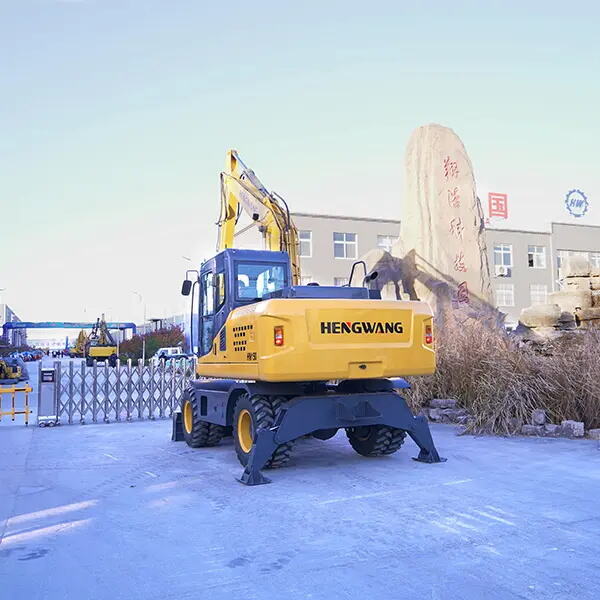Construction professionals are increasingly turning to wheeled excavators as their equipment of choice for various projects. These versatile machines combine mobility, power, and precision to deliver outstanding performance across multiple applications. Understanding how wheeled excavators can accelerate project completion and enhance productivity is crucial for construction managers and contractors looking to optimize their operations.
The unique design of wheeled excavators, featuring rubber tires instead of traditional tracks, allows for swift movement between job sites and superior maneuverability in urban environments. This mobility advantage, coupled with their impressive digging capabilities, makes them indispensable for modern construction projects where time efficiency is paramount.
Wheeled excavators excel in road construction and maintenance tasks, offering unparalleled efficiency in urban settings. Their rubber tires prevent damage to existing pavement, allowing them to move quickly between different sections of a project without requiring additional transportation equipment. These machines can swiftly handle tasks such as drainage installation, utility work, and road surface preparation.
The ability to travel at higher speeds compared to tracked excavators means less downtime between work locations, resulting in faster project completion. Additionally, their precise control systems enable operators to perform delicate operations around existing infrastructure without risking damage to underground utilities.
When it comes to installing or maintaining utility lines, wheeled excavators demonstrate remarkable efficiency. Their superior mobility allows them to navigate through tight urban spaces, while their precise controls enable quick and accurate trenching for power lines, water pipes, and telecommunications infrastructure.
These machines can rapidly switch between different attachments, making them ideal for complex utility projects that require various tools. From digging trenches to placing pipes and backfilling, wheeled excavators complete these tasks with minimal surface disruption and maximum speed.

In commercial and residential development projects, wheeled excavators significantly reduce site preparation time. Their ability to move independently between different areas of a construction site eliminates the need for traditional transportation methods, accelerating the overall grading process.
The machines' versatility allows them to handle multiple tasks efficiently, from clearing vegetation and removing debris to precise grading and leveling. Their excellent stability and control make them particularly effective for creating proper drainage slopes and preparing building foundations.
Material handling operations benefit greatly from the speed and mobility of wheeled excavators. These machines can quickly move between storage areas and work zones, efficiently loading trucks or relocating materials across the site. Their swift rotation capabilities and precise bucket control enable faster loading cycles compared to traditional equipment.
The ability to handle various attachments means one wheeled excavator can perform the work of multiple specialized machines, reducing equipment costs and improving project timelines. From handling bulk materials to precise placement of construction elements, these versatile machines excel in keeping material flow efficient.
Landscaping projects require both power and precision, areas where wheeled excavators demonstrate exceptional capabilities. These machines can rapidly reshape terrain while maintaining the delicate touch needed for final grading and contouring. Their mobility allows them to work efficiently across large areas, creating natural-looking landscapes in less time.
The superior maneuverability of wheeled excavators makes them particularly effective for projects requiring frequent repositioning, such as creating berms, water features, or complex topographical elements. Their ability to work on finished surfaces without causing damage speeds up project completion significantly.
When it comes to land clearing and tree removal, wheeled excavators offer impressive efficiency. Their powerful hydraulic systems combined with specialized attachments allow for quick removal of vegetation and stumps. The machines can move swiftly between work areas, maximizing productivity in clearing operations.
The ability to handle multiple attachments means one wheeled excavator can complete the entire clearing process, from cutting and removing trees to grinding stumps and processing debris. This versatility eliminates the need for multiple specialized machines, accelerating project completion while reducing costs.
Wheeled excavators can travel at speeds up to 25 mph on improved surfaces, significantly faster than tracked excavators which typically max out at 3-5 mph. This increased mobility allows for quicker transitions between job sites and more efficient work in urban environments.
Wheeled excavators can utilize a wide range of attachments including buckets, hydraulic hammers, grapples, augers, and specialized tools for specific tasks. The quick-change systems on modern wheeled excavators allow for rapid attachment switches, minimizing downtime between different operations.
Yes, wheeled excavators are ideal for working on finished surfaces such as roads and parking lots. Their rubber tires cause minimal damage compared to steel tracks, and they can be equipped with outrigger pads to distribute weight evenly during stationary operations, protecting the working surface.
 Hot News
Hot News2024-10-31
2024-10-28
2024-10-25
2024-10-23
2024-10-21
2024-09-03